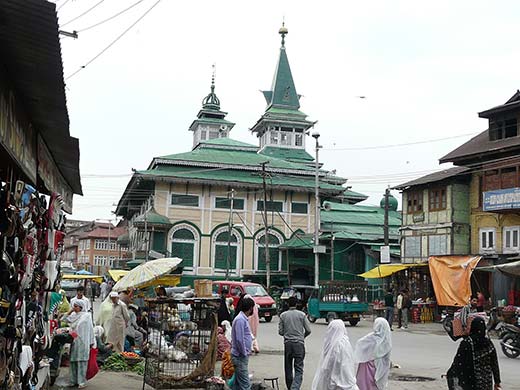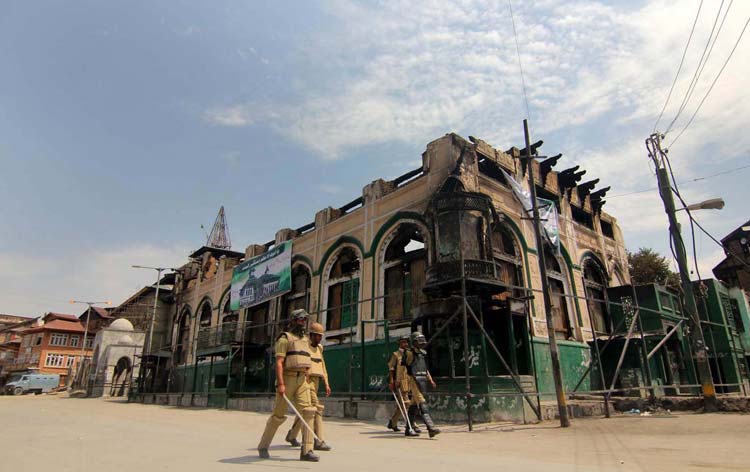Intach’s effort to document historically important structures in Kashmir came handy while rebuilding devastated Dastageer Sahib Shrine. Ubeer Naqushbandi reports the behind the scene work that made it all possible

On June 28, 2012, three days after Dastigeer Sahab shrine in Khaniyar went up in flames, leaving entire Kashmir fuming with anger, and under strict curfew, the phone at Intach’s Srinagar office began ringing frenetically. In a no-nonsense tone, the man on the other end said: I am from CM’s office. Gear up and start loss assessment of the shrine. We need a detailed proposal. An hour later Intac team was on their way to the Dastgeer sahib shrine. “We were given special curfew passes,” recalls Hakeem Sameer Hamdani, Project Coordinator Intach.
The reason, then Omar Abdullah led government was sure that Intach will get them out of the crisis was their previous work. “We had done intensive documentation of the shrine in 2005-06,” said Sameer.
This visuals documentation of motifs, khatamband, art, woodwork, papier-mâché, designs etc. helped Intach retain the originality. “The idea was to recreate the old structure as it was,” said Sameer. “It was quite a challenging task given the sentiments attached with the shrine.”
A few months back, when one of the old devotees, who also took care of the shrine before it was gutted in fire, entered the reconstructed shrine, he couldn’t help but say, “They (Intach) have not done anything at all. It (shrine) looks exactly the same!”
In 2005, Intach, a Delhi based non-profit organisation, was tasked to document around eight hundred historically important structures across Kashmir. Dastageer Sahib Shrine was one among them. “Documentation involved video-graphing of heritage structures, images and minute details with regard to structure building,” said Sameer.
For Intach, the project was important given the fact that most of the buildings in the list were made of wood, and were currently in dilapidated condition. “These structures were highly prone to catching fire,” said Sameer.
Their apprehensions had reason: the shrine of Noorudin Wali in Chrar-e-Sharief and Khanqah-e-Faizpanah in Tral were completely lost in fire. In absence of any material evidence, or photography record, these shrines couldn’t be restored to their original glory. The first heritage building that Intach chose for documentation was “haunted” Aali Masjid of Eidgah, Srinagar. Built in 1471, Aali Masjid is the second largest mosque in Kashmir. “When we took over, there were several theories attached to this mosque,” said Sameer.
But what pinched Intach team was how this once beautiful structure was dying for want of attention. “We not only documented the mosque but restored its previous glory.”
After Intach’s intense restoration work Aali Masjid was finally thrown open for prayers, something unimaginable a few months back. The next in line for documentation was Khanqah Shah-e-Hamdan, Jamia Masjid Srinagar, Naqashband Sahib Shrine, Makhdoom Sahib Shrine, Dastigeer Sahib Shrine etc.
Also, Zain-u-din Wali’s shrine in Aishmuqam and Janbazz Sahib’s shrine in Baramulla were documented by Intach. “Once they saw results, tourism department showed interest in our documentation project,” said Sameer.
As a “goodwill gesture” tourism department bore transportation expenses of Intach employees. “They gave us Rs 1 lakh,” said Sameer. “It was too small but we didn’t complain.”
The entire documentation process took two years to complete. “By 2007 we were done with our entire list,” said Sameer.
Last time such a massive exercise of documentation of historically important buildings took place was 1930. The British archaeological team was led by Sir John Marshall. He documented many structures across Kashmir including Khanqah-e-Maulah and Jamia Masjid Srinagar.
A week before Dastegreer Sahib Shrine was gutted, Sameer and his team gave a power-point presentation regarding safety of heritage buildings to then Parliamentary Affairs Minister Ali Mohammad Sagar. The presentation, which took place in the lawn of Shah-e-Hamdan Shrine, was attended by Wakaf men, and custodians for important shrines. “We told them how some of the shrines with rich heritage value can be brought under UNESCO’s care,” said Sameer.
During the presentation, it came to light that there are only three fire extinguishers in Dastageer Sahib Shrine. Interestingly no custodian knew how to operate an extinguisher in case of a fire. “We also highlighted how Dastageer Sahib’s electric wiring is in mess,” said Sameer.

After the fire, when Intach shared its plan for reconstruction, people raised objections. Reason: Intach wanted to retain some of the walls that were not damaged and were absolutely safe. However, locals wanted these walls to be destroyed and rebuilt from scratch because were sprayed with “dirty water” during fire-fighting.
Then there was lack of consensus viz-a-viz what kind of structure should be built now: the one that was already there, or something modern. “Wakaf was interested in rebuilding the Shrine on modern lines,” said Sameer.
Their (Wakaf’s) idea was to have a shrine with around sixty thousand capacity, huge open space, etc. However, during a meeting with Wakaf members Omar Abdullah made it clear that Shrine will be built on old pattern. One senior Wakaf member told CM that his grandfather late Sheikh Abdullah built Dargah Hazrabal using modern outlook, why not replicate the same?
Omar told him that Hazratbal doesn’t look Kashmiri at all in terms of architecture, “I don’t want to do the same with Dastegheer Sahib Shrine.”
Finally when the work started in September 2012, everybody was keeping his fingers crossed; after all it was no ordinary building. Out of the estimated cost of Rs 16 crore, so far Intach and JKPCC have spent Rs 9 crore.
The reconstruction was done using old plinth as base. “All building material was used keeping in view the carrying capacity of that plinth,” said Sameer. “It was very challenging. There was no margin of error whatsoever”.
The walls of the shrine had 13 inch thick wooden logs that gave the structure flexibility and strength. “We kept the thickness of the walls same, only difference was they were hollow now. There is no wood,” said Sameer. This helped in reducing the usage of wood by sixty per cent compared to old structure. While reconstructing the shrine extra care was taken with regard to electrical fitting.
“Wires are laid in such a way that chances of short circuit are minimal,” said Sameer.
Ask Sameer what was the most challenging part of the reconstruction, and he quickly says: interior work. “If you remember old shrine had very intricate mix of Khatambandh, papier-mâché, wood carving, calligraphy work etc.,” said Sameer. “To replicate that was very tough.”
This part was done using old photographs, documents, videos etc. “We would compare samples with old documents before going ahead,” recalls Sameer.
Besides, videos provided by Tariq Bhat of Associate Media, proved vital in understanding the motifs.
“The successful completion of shrine only proved that Kashmiri artists are still in touch with their craft,” feels Sameer. “All designs are from the old shrine.”
As of now work is stalled due to lack of funds, but Sameer and his colleagues are not worried, as most of the work is done already. “Challenging part is already over. Now just finishing touch is left.”















